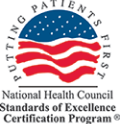Alpha-1 Antitrypsin Deficiency (Alpha-1) can cause damage to the liver. It’s important for all people with Alpha-1 to be checked for liver disease.

What are the symptoms of liver disease in people with Alpha-1?
Although most people with Alpha-1 have no symptoms of liver disease, Alpha-1 can cause liver problems in infants, children, and adults.
Some people with Alpha-1 will have little or no liver disease, while others may develop severe liver disease.
In babies, symptoms of liver disease include:
- Jaundice (the skin and/or eyes turning yellow)
- Pain and/or swelling in the belly
- Poor growth or lack of normal weight gain
- Diarrhea
Most infants with jaundice do not have liver problems; their jaundice usually lasts just a few days and is harmless. Blood tests can tell if the jaundice is caused by Alpha-1.
However, some infants have scarring of the liver that leads to the need for a liver transplant in the first few years of life. This is rare; most children with Alpha-1 liver disease reach adulthood without major liver problems.
In adults and older children with Alpha-1, symptoms of liver disease include:
- Jaundice
- Pain and/or swelling in the abdomen/belly and/or legs
- Vomiting blood or having blood in the stool
- Itching that doesn’t stop
- Feeling weak and tired
Why does liver disease develop in people with Alpha-1?
Normally, the liver makes a protein called alpha-1 antitrypsin (AAT), which then travels through the bloodstream to help protect the lungs and other parts of the body.
In people with Alpha-1, larger than usual amounts of AAT are made in the liver, and this protein is made in a different shape than usual. In people with Alpha-1, almost 85 percent of this protein builds up in the liver and is unable to get to the lungs and other organs.
If the liver cannot break down the abnormal protein, the liver gradually gets damaged and scarred, resulting in a condition called cirrhosis. Cirrhosis can result in intestinal bleeding, fluid in the belly (ascites), and other health problems.
Not everyone with Alpha-1 develops liver disease. Researchers are working on discovering other factors that may contribute to the development of liver disease in some Alphas.
How is liver disease detected in people with Alpha-1?
In someone with Alpha-1, a doctor may check for liver disease with a physical examination and blood tests. A physical exam may show a liver or spleen that is larger and firmer than usual. Blood tests can measure how much of the AAT protein is in the blood and how well the liver is working.
In addition, the doctor may order an ultrasound of the liver. This is a painless procedure that uses sound waves to create a picture of the liver.
A liver biopsy is usually not needed to diagnose Alpha-1 but may be used to see how badly the liver is damaged. A biopsy involves receiving local anesthesia to numb the skin and prevent pain. A doctor pushes a needle through the skin into the liver and removes a small piece of the liver with the needle. The piece of liver is then analyzed in a laboratory.
Can liver disease be prevented in people with Alpha-1?
Although Alpha-1 cannot be cured, there are ways to prevent or reduce health problems related to Alpha-1, including liver disease.
The best ways to prevent liver problems in someone with Alpha-1 include:
- Avoid drinking alcohol and using tobacco (including smoking and vaping)
- Eat a healthy diet and maintain a healthy weight
- Get vaccinated against Hepatitis A (hep A) and Hepatitis B (hep B), which can lead to liver damage
- See a doctor for regular checkups and recommended screenings, which may include blood tests, ultrasounds, X-rays, or CT scans
- Talk to a doctor before using any herb, vitamin, or other therapy; some of these items may cause liver damage
If you have Alpha-1, you should avoid drinking alcohol to prevent liver disease from developing or worsening
How is liver disease treated in people with Alpha-1?
Some symptoms of liver disease caused by Alpha-1 can be treated with medications. These include jaundice, internal bleeding, itchiness, and a buildup of fluid in the belly.
In people with severe scarring of the liver (cirrhosis) caused by Alpha-1, a liver transplant may be necessary. A liver transplant involves surgery to remove the diseased liver and replace it with a healthy one that has been donated by another person. A healthy liver should make normal AAT.
Read the Liver and Alpha-1 Brochure to learn more about Alpha-1 and liver disease
Watch this video: Understanding Alpha-1, Vital Organs–Liver and Lungs











